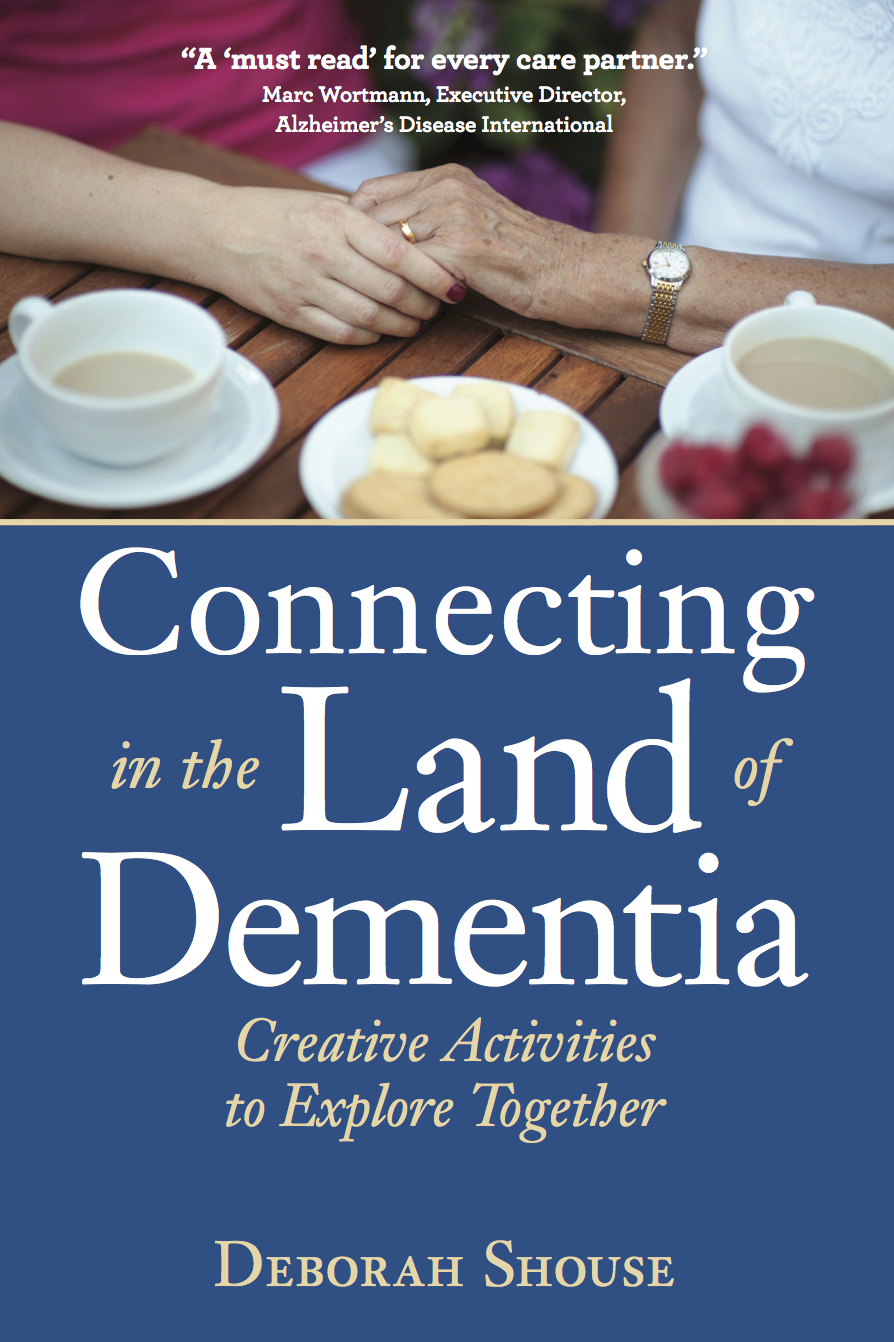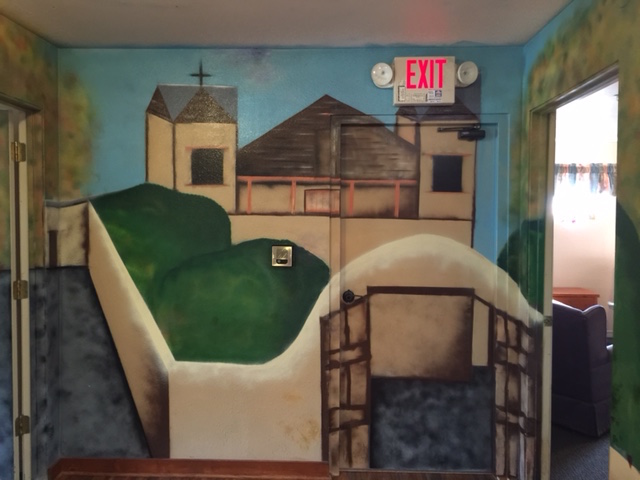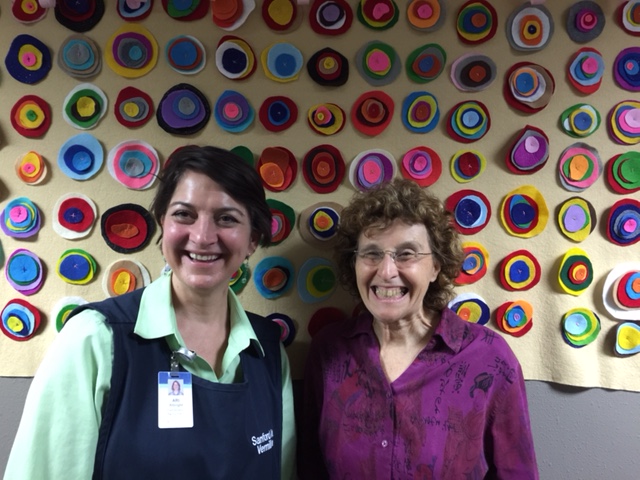Posts Tagged ‘Art’
An Art Lesson in Paris
An integral part of experiencing Paris is looking at art. Chantal Debreu, a psychotherapist, serves as a volunteer and board member of the city’s Action Culturelle Alzheimer. To properly discuss the fascinating programs Chantal and her colleagues designed in collaboration with Musée d’Orsay, Musée de Cluny, and the Château de Versailles, we met at a sidewalk café over croissants and coffee.
(Note to fellow writers: It is extremely difficult to enjoy a croissant while typing on an iPad. The flakes flutter festively about the keyboard.)
Art Speaks a Universal Language
“Art is a universal language and looking at art is a wonderful way to access the creative capacities of people living with dementia,” Chantal says. “Looking at and discussing art can also at least temporarily reduce issues such as agitation, depression, apathy, and aggression.”
To facilitate such cultural connections, Chantal and Cindy Barotte, founder of Action Culturelle Alzheimer, created a three-day training program for volunteers, complete with information about dementia, case studies, and role play. Cindy developed a structure for finding meaning in works of art for volunteers and museum educators. The program connects each beneficiary with a trained volunteer who is there for five gallery visits. During the art experience, the caregiver has much-needed respite time.
“The volunteer helps people living with dementia explore their own capacities by supporting them,” Chantal says.
 The structure encourages engagement and creative expression. To view the work of art, participants sit in a semi-circle, so they can see and hear each other. The semi-circle creates a sense of group belonging and also blocks out the public. The volunteers sit in back of their person. If the person with dementia feels shy about speaking out, they may turn and share with their volunteer. The volunteer reports the insight to the educator, who shares it with the group.
The structure encourages engagement and creative expression. To view the work of art, participants sit in a semi-circle, so they can see and hear each other. The semi-circle creates a sense of group belonging and also blocks out the public. The volunteers sit in back of their person. If the person with dementia feels shy about speaking out, they may turn and share with their volunteer. The volunteer reports the insight to the educator, who shares it with the group.
Art Breaks Ice and Inspires Ideas
The program inspires conversation and ideas. People living with dementia tend to notice the details, but they may not attach a meaning to them. Little by little, the facilitators talk through the elements of the painting, helping them associate and build meaning, so they understand the story of the painting. When they start to make associations, they talk about their experiences. They come away feeling like they are someone; they have ideas and memories to share.
“At the Centre Pompidou, we discussed Bleu, a giant Miro canvas,” says Chantal. “We talked about it for 15 minutes. Everyone was involved and actively engaged in investigating, wondering, and sharing.”
Art Travels with You
Want to bring the Paris art experience home? Here are some tips:
- Select a work of art to comfortably view together, either on-line, from a book, or at a local gallery.
- As you look, ask open-ended questions, such as, “Why is that woman staring?”
- Encourage conversation by continuing to ask engaging questions. If someone notices a bicycle, make an affirming comment about the bicycle and ask “What else do you see?”
“It’s not about telling,” Chantal says. “It’s about asking.”
For more on the international scene, dive into my book, Connecting in the Land of Dementia: Creative Activities to Explore Together. Pre-order your signed copy.
Orchestrating a Musical Conversation
When Ron’s dad was living in a memory care unit, Ron and I talked with the residents and their families, learning about their favorite songs. We orchestrated a sing-along and had fun working with everyone and putting together a scrapbook of each resident’s special tunes. The combination of music and conversation created a sense of community for us all. Julian West, who we met on a recent trip to London, is creating community through engaging people in music and dance. We really love the way he weaves the two art forms together and wanted to share his easy and adaptable ideas with you.
Julian West had no idea what would happen at the care facility, but he trusted it would be something wonderful. An accomplished oboist and a teacher at the Royal Academy of Music, Julian assembled a violist, a composer, a dancer, and an artist to share energy and their art with people who are living with dementia.
“This was an experiment to see what could happen,” Julian says. “We worked completely improvisationally.”
Once a week, for eight weeks, the troupe came to the residential care home and created a living arts experience with residents and staff. They began by inviting everyone to choose a percussion instrument, such as rain sticks, bells, shakers, tambourine, etc.
“We had a musical conversation,” Julian says. “One person made a sound and another answered. We also chatted a lot. People commented on the music or expressed an emotion or impression.”
The musicians added their instruments and the staff and residents joined in, through percussion and voice. They made fascinating sounds, like an improv jazz singer might do. The dancer twirled around in the center of their circle. Her free movements gave the group a focal point and inspired others to explore various movements.
“I let go of preconceptions and tried to create an open atmosphere,” Julian says.
The artists’ openness helped the “conversation” grow and blossom.
One woman who was living with dementia held up a tambourine, keeping it still and gazing at it as though it were a beautiful and revered object.
Julian’s first thought was, “She doesn’t know it’s a musical instrument”.
“I let that thought go,” he says. “I saw how expressive she was. Her interaction with the tambourine was beautiful and profound and she allowed us all to see the instrument differently.”
Even if you don’t have your own musicians and dancers at home, you can still create this supportive and creative atmosphere.
- Share a few percussion instruments, put on some music you both like, and make some joyful noises. Experiment with bee-bop syllables to add a sense of freedom.
- After the song, talk about the experience, what you liked, what you felt, and any other impressions that came up.
- Consider inviting a “guest dancer,” someone who likes to move to music, or a child of a friend who’s taking dancing lessons. Go ahead and add your own moves.
- Invite friends and family to join you. You’ll have something to laugh, and sing, and talk about.
For more information about Julian’s work, visit: www.julianwest.co.uk
Tips from a Parisian Artist
 There’s something magical about visiting an artist in his studio. Especially if that studio is in Paris. We were honored to meet Patrick Laurin, artist and art therapist, on a recent trip to France.
There’s something magical about visiting an artist in his studio. Especially if that studio is in Paris. We were honored to meet Patrick Laurin, artist and art therapist, on a recent trip to France.
In the beginning, Patrick Laurin’s work with people who were living with dementia went slowly. When he first visited the care home and invited people to join him for painting, he heard various reasons the idea wouldn’t work. “I can’t hear you.” “I can’t see you.” “I can’t move my arm.”
 Patrick, who had quit working as researcher in the pharmaceutical industry so he could create deeper connections with clients, understood the importance of building relationships. Gradually, he got to know the people who lived in the community. He wanted to tailor an artistic experience specific to each person’s abilities and needs.
Patrick, who had quit working as researcher in the pharmaceutical industry so he could create deeper connections with clients, understood the importance of building relationships. Gradually, he got to know the people who lived in the community. He wanted to tailor an artistic experience specific to each person’s abilities and needs.
Over time, the people who couldn’t see, hear, or move were all happily involved in painting.
One woman seemed to blossom when holding the brush and stroking on the paint. Even though she couldn’t later remember to say, “I’ve been painting,” she enjoyed the experience.
One day, Patrick was on another floor in the care community when he encountered this woman and her daughter.
Her daughter said to Patrick,” You are the painter.”
Patrick was thrilled her mother had been able to mention the art therapy sessions. But before he could respond, the mother said, “No, the painter is me.”
“Inside, she was seeing herself as an artist,” Patrick says. “The painting strengthened her identity.”
 Patrick has learned to approach each person with flexibility. Sometimes Patrick jump starts his artists with a squiggle of color on the page. Then he steps back to let them respond with their own squiggle. If they’re stymied, he offers a choice of two colors.
Patrick has learned to approach each person with flexibility. Sometimes Patrick jump starts his artists with a squiggle of color on the page. Then he steps back to let them respond with their own squiggle. If they’re stymied, he offers a choice of two colors.
He also uses collage techniques to inspire his artists. He selects three separate pictures, each with one recognizable thing, such as a house, tree, or dog. He shows the photos to the artist, and asks, “Which one of these attracts you?” When the artist chooses a photo, Patrick then asks, “Where would you like to put this on the paper?” He and the artist apply paste to the paper.
“We don’t turn over the picture and apply paste, because the image then disappears and that can be confusing,” he says.
When the picture is glued to the paper, Patrick discusses a color that’s already in the picture.
“You could take the blue in the sky and extend it,” he might suggest. This suggestion often inspires the artists to start painting. If they get stuck, Patrick says, “What might look good near the house?” In this way, the painting expands.
For one woman, painting began as a series of colors and grew into a personal story.
She pasted a house and began expanding the lawn. Then she drew a bridge and weeks later, she added in a dog. At first, she was painting “a house, a bridge and a dog.” As the picture took shape, she said, “This is my house and my dog and this is the bridge we had to cross to get to the house.” The process of painting had loosened memories of her childhood home.
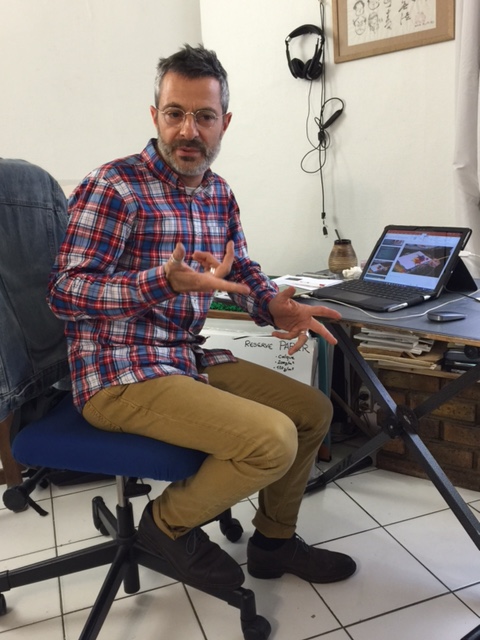 “When I share a piece of art by one of my students, I also share the story behind it,” Patrick says. “The act of creation is more important than the results.”
“When I share a piece of art by one of my students, I also share the story behind it,” Patrick says. “The act of creation is more important than the results.”
Tips:
Pick something that is easy for you, the care partner.
Put a point of color on the pages, then stand back. Offer support but don’t paint.
Enjoy the process and don’t get stuck on the results.
Thanks to Berna Huebner, founder of the Hilgos Foundation and co-producer of the documentary, “I Remember Better When I Paint,” for suggesting we meet with Patrick.
Click for Poetry and Help Hundreds
My friend Molly has an exciting opportunity to expand the creative work she is doing with those who are living with dementia. She’s in the running for a small business grant from FedEx. Read this blog to learn more about the meaningful projects she is doing. If you are as inspired as I am, simply click on the link and vote for Molly and Mind’s Eye Poetry: http://bit.ly/1TgpDuJ
A brief silence unfolds while people consider.
“I used to wrap a scarf around my head in the convertible,” one woman says.
The woman sitting next to her smiles. “Scarves blow in the wind,” she says.
Molly mimics the scarf wafting in a breeze.
“If the scarf was music, what kind of music would it be?” Molly asks.
“Jazz,” a man says.
“Rock and roll.”
“Classical.”
Molly, who has an MFA and is the creator of Mind’s Eye Poetry in Dallas, Texas, reaches into her suitcase and brings out a small watering can. She continues the relaxed pacing, asking for impressions, invoking imagination, creating a sense of comfort and connection for this group of people who live in a memory care facility.
After 20 minutes of creative play, Molly takes out a slim book and says, “Here’s a poem about spring that I really like. See what you think.”
She reads the short, rhyming verse and asks for reactions. She then invites the group to contribute to a writing project.
“There are no wrong answers,” she assures them. “I’ll ask something and you’ll say the first thing that comes into your mind. For example, when I say ‘springtime’ what flowers do you think of? ”
“Daffodil, tulip, roses…” the group offers.
Molly writes down each flower and reads it back to the group.
“We have our first line of poetry,” she tells them.
“Imagine where the flowers are, in a vase, in the garden?”
“What colors are they? What time of day is it?”
Every question invites imagination and word-by-word, the poem emerges. After they’ve created three short poems, Molly shows them a piece of art and asks, “What do you see?” She captures their observations and uses their words to create a poem.
Here’s an example of a poem segment created after looking at Oriental Poppies, Georgia O’Keefe’s painting of two large orange poppies.
I see two evening gowns
on a diagonal, flowing.
I see a Scottie dog
prancing in a field of orange.
I see summertime in Santa Fe.
I see a black bird soaring into sunset.
“When I read back their words and say, ‘You all just wrote this,’ it’s very empowering,” Molly says.
For those at home who want to have a session of creative imagining, Molly has these suggestions:
Gather a few interesting objects, such as a recipe book, a nature photo, a pot holder, and one at a time, show them to your partner and ask, “Mom, what do you think about when you see this recipe book?” Give her plenty of time to respond and jot down her answers. If she asks, “Why are you writing?” tell her, “I value what you have to say.”
Soon, you’ll have a collection of words and phrases. You can take a photo of the object along with the poem it inspired and put them together in a book. #
Molly Middleton Meyer is the founder of Dallas-based, Mind’s Eye Poetry. To date, she has facilitated over 600 poems written by people with dementia. Mind’s Eye Poetry has been featured in U.S. News and World Report, the Huffington Post, the Dallas Morning News, Affect Magazine, Growing Bolder Magazine, and on NPR. When Middleton Meyer is not facilitating poetry, she writes her own. Her first book of poetry, Echo of Bones was published in 2014. For more information, contact Molly Middleton Meyer, M.F.A. Poetry Facilitator/Speaker at www.mindseyepoetry.com
Deborah Shouse is the author of Love in the Land of Dementia: Finding Hope in the Caregiver’s Journey.
COMING SOON: CONNECTING IN THE LAND OF DEMENTIA: CREATIVE ACTIVITIES TO EXPLORE TOGETHER
Dementia Café: Connecting through Donuts and Baseball
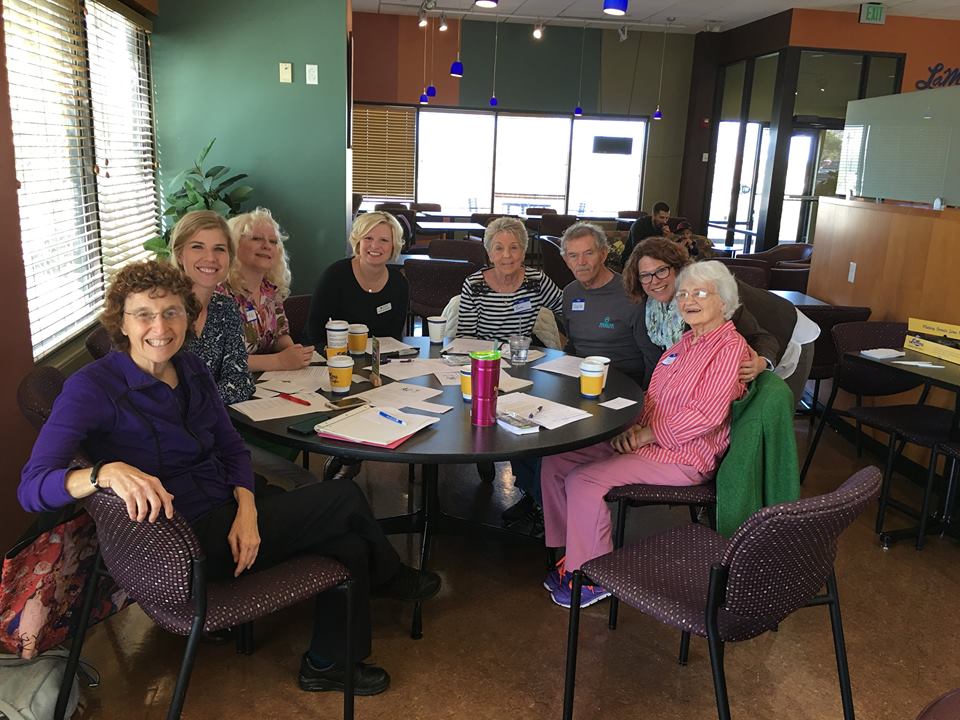
I’ve always enjoyed gatherings of creative people, so I was excited when I learned that Mandy Shoemaker was orchestrating a Dementia Café in our area. The premise is simple and fun: a group of people living with dementia, their care partners, and friends get together in a public space for a facilitated time of conversation, sharing, and creativity.
Mandy’s café took place in Lamar’s, a locally esteemed donut shop with a quiet atmosphere and a spacious seating area. Eight of us gathered around a table and Mandy opened the conversation by showing us a black and white photo of a baseball player laying on a field, next to a fence, apparently knocked out.
“Babe Ruth,” she told us. “He was running backwards to catch a ball and crashed into the barrier.”
We all nodded in sympathy, then began sharing baseball stories. Charlie had played in his youth and he and his wife Barb were ardent Royals fans. Courtney had played softball in high school. Fran, who grew up in the 1930’s in rural Mississippi, never had a chance to play sports but she liked hearing about the game.
“Did you ever listen to baseball on the radio?” Mandy asked her.
“In those days, not everyone had everything,” Fran said. “I don’t think we even had a radio.”
Barb remembered being on her grandparent’s farm, huddled around the radio, listening to the Yankee’s games.
“Have you ever heard the poem Casey at the Bat?” Mandy asked.
“I memorized it at school,” Charlie said.
 We took turns reading the dramatic poem, discussing such vivid terms as “when the dust had lifted” and “Casey lightly doffed his hat,” and one ball player was a “lulu” while another was “a cake.” The tension built and we chanted the last verse together. (Seek out this poem if you want to know what happened in Mudville that day: www.baseball-almanac.com/poetry/po_case.shtml )
We took turns reading the dramatic poem, discussing such vivid terms as “when the dust had lifted” and “Casey lightly doffed his hat,” and one ball player was a “lulu” while another was “a cake.” The tension built and we chanted the last verse together. (Seek out this poem if you want to know what happened in Mudville that day: www.baseball-almanac.com/poetry/po_case.shtml )
We then created a group poem, each contributing an answer to “Baseball is…”
I left the café feeling exhilarated and connected. Baseball was a catalyst for a great conversation that included life in the 1930s, family origins, Memphis, Elvis, baseball cards, Abbott and Costello, poetry, women and sports, fathers, hard work, radio programs, and more.
“It is our goal to create a more dementia-friendly community,” Mandy says. “Part of that is creating safe places for people with dementia to come and be a part of a group, with no expectations. The café invites people to just get out, be creative, and have fun.”
The KC Memory Café will meet on the second Tuesday of each month. To keep up to date, follow our facebook page at www.facebook.com/KCMemoryCafe
Create Your Own Cafe
You can also create your own café for two or more. Here are a few tips:
Select a public meeting place that serves refreshments and is reasonably quiet.
Let go of expectations and create a supportive atmosphere. You are here to express yourselves and connect.
Pick a broad topic that you are both interested in. Examples include seasons, sports, nature, games.
Start with a visual stimulation, such as a photo. Ask open-ended questions that invite imagination, such as “What do you see in this picture?” or “What do you think is going on?”
Allow the conversation to flow. The topic is a mere catalyst for ideas and communication.
Print out a familiar poem to read together. Enjoy the drama of reading aloud and invite comments on the poem.
For more about starting a café, visit
http://www.alzheimerscafe.com/public.html.alzheimersatoz.com/Welcome.html
Deborah Shouse is the author of Love in the Land of Dementia: Finding Hope in the Caregiver’s Journey.
COMING SOON: CONNECTING IN THE LAND OF DEMENTIA: CREATIVE ACTIVITIES TO EXPLORE TOGETHER
Three Tips for Living Large Inside the Box
How can we all stay connected with our creative spirits during the dementia journey?
I’ve been very inspired by people who are connecting both with care partners and with those living with dementia, through artistic and creative expression. I recently read this blog by Matt Stevens, a designer and illustrator based in Charlottesville, NC. Best known for his MAX100 project, 100 interpretations of the same object (the Nike sneaker). Matt has also worked on identity and branding for clients such as Pinterest, Facebook, Evernote, Dunkin’ Donuts, and the NBA. His thoughts on creativity and repetition seem applicable to the care partner’s journey.
How Rules and Repetition Inspire Creativity
For centuries, artists have been exploring the benefits of working with constraints. Bach composed the Goldberg variations — an aria and 30 variations for a harpsichord — in 1741. Picasso created an 11-lithograph series of bull illustrations in 1945. Matt Stevens reinterpreted the same object in his MAX100 project and has serialized a number of his other works as well. Great artists and designers impose constraints to inspire their creativity.
“I noticed how often I create repetition in my work – systems for myself to operate within,” Matt says. “I asked myself: Why do I create this repetition? Why do I love series so much?”
Limitations force you to be inventive and create new paths.
With Matt’s MAX100 project, he focused on a single image — the iconic Nike sneaker — and reinterpreted it 100 times.
The rules were simple: the shoe had to be in the same position on the page (it couldn’t be turned), and it had to be fundamentally changed. It wouldn’t be enough to add patterns around it: he would iterate on the shoe itself, over and over again.
“The idea is to take something, abstract and change it and let the narrow focus of the project give you a sense of freedom as you move through it. How far could I push it? How much could I abstract it?”
For Matt, this exercise led to a successful Kickstarter that turned into a book, client work with Nike themselves, plus an art exhibition in New York. #
From Deborah.
One of the ways I tried to learn from creative limitation was exploring new ways to answers my mom’s repetitive questions. I also experimented with new ways to bring joy and creativity to our time together in the care home. Even though Matt’s tips are targeted towards the artistic community, I find them thought provoking and hope you will too.
Here are a few more ideas from Matt:
No project happens overnight. Your process for setting a project with the right limitations is important.
- Define the problem
Choose your subject and your challenge. You may be trying to understand a fellow designer’s technique. You may really just love an icon. You may want to learn a new skill. Define the problem and what you will focus on. The MAX100 project, for instance, started as a project for Matt to learn more about illustration.
- Limit your options in solving the problem
“Limited options provide clarity. And when you get stuck, sometimes the answer is not more; but it’s less.”
Impose a structure and set some rules to explore your concept. What rules will you create by? Create a baseline structure to operate within, whether that’s the medium you are trying to learn, or the logo you are trying to explore.
- Iterate, explore, learn, repeat
Don’t get stuck on the unknowns. Don’t be afraid to imitate the styles of people you admire as you go, either: these can set off their own series of explorations. Pick those apart and understand how they work. You may start to see the task in new and unexpected ways, and explore anew from there.
Remember that when you get stuck, sometimes the answer is not more, but less.
To learn more about Matt Stevens, visit
Deborah Shouse is the author of Love in the Land of Dementia: Finding Hope in the Caregiver’s Journey.
Fringe Forward with this Edgy, Engaging, and Evolving Theater
For Deb Campbell, Executive Director, Kansas City Senior Theatre, the playwriting process starts with deep listening. When she decided to create a play about dementia for the Kansas City Fringe Festival, she turned to her colleague and friend, Johnna Lowther, for inspiration and support. Together they began a creative exploration by gathering groups of care partners and people with dementia. Deb designed group activities to get everyone connected to each other and to the topic.
Ron and I were honored to participate in one of Deb’s listening groups.
“Choose a word,” she tells us and we select a word from a tumble on the table. Then she asks each person to add their word onto a magnetic board and tell us why they picked it.
One man chooses “apparatus.” He explains, “I’ve worked with tools most of my life. Since the Alzheimer’s, I can’t trust myself. I’ve put the tools away.”
One man selected ‘gorgeous’. “My wife, Annie, loved that word. She described everything as gorgeous, her engagement ring, flowers, a teacup, a bedspread. Everything was gorgeous to Annie. She was gorgeous to me.”
The stories around the words have us leaning forward in our chairs. Deb draws us further into our own stories. She asks us to select from a pile of masks, then invites us to put on the mask and speak.
“Don’t forget the real me,” one person says.
“I’m not trying to hide,” says another.
We all have a turn holding a steering wheel.
“If you were driving this play, where would you take it?” Deb asks.
“In reverse,” a woman says. “I feel like that’s the direction I’m going.”
“My wife keeps getting lost,” a man says. “I now have to take the wheel.”
After the listening sessions, Deb reaches out to people to see if they’d like to share additional stories. She then meets them at their homes to record what they have to share. The stories are transcribed exactly as they are told.
“I’ve learned I can’t hurry the process,” she says. “I just let the stories flow in.
Once Deb has collected all the stories, she begins to hone in on the play.
“I become obsessed,” she says. “I devour the material, slosh around in it, and immerse myself. I feel overwhelmed, yet I trust the process.”
She plans to let the play unfold organically. Her job is helping people reveal their experiences. She won’t shape the drama until the theme emerges from her collection of powerful personal stories.
Originally, she used an image of her mother-in-law’s gnarled hand holding onto her baby grandson’s hands. She thought the play’s theme would be “Hold On.” But as she listened to stories and collaborated with Johnna, she realized the play is about accepting the present instead of holding on to the past. An image of building blocks burst into her mind. Those blocks, once again marked with words, now anchor the play, which is titled, Seven Stages, Seven Stories.
The play will debut July 18 at 7:30 during the KC Fringe Festival and will play several times during the festival. The cast is a mixture of people with early onset dementia, care partners, storytellers, and experienced actors.
Ideally, audiences will be inspired by the depth and complexities of the people who are living with this disease and by the love and connections inherent in the journey.
Treat yourself to a meaningful theater experience. Come to Phosphor Studio 1730 Broadway Blvd. (across the street and south of Kauffman Center).
Saturday, July 18th 7:30
Tuesday, July 21st 6:00
Thursday July 23rd 6:00
Saturday, July 25th 4:30
Visit the Fringe website to get tickets and for any changes in scheduling: www.KCFringe.org
Visit Kansas City Senior Theater for more about Debra’s work:
Deborah Shouse is the author of Love in the Land of Dementia: Finding Hope in the Caregiver’s Journey.
Bringing Eden Home: Experiencing A Comforting Concept in Elder Care
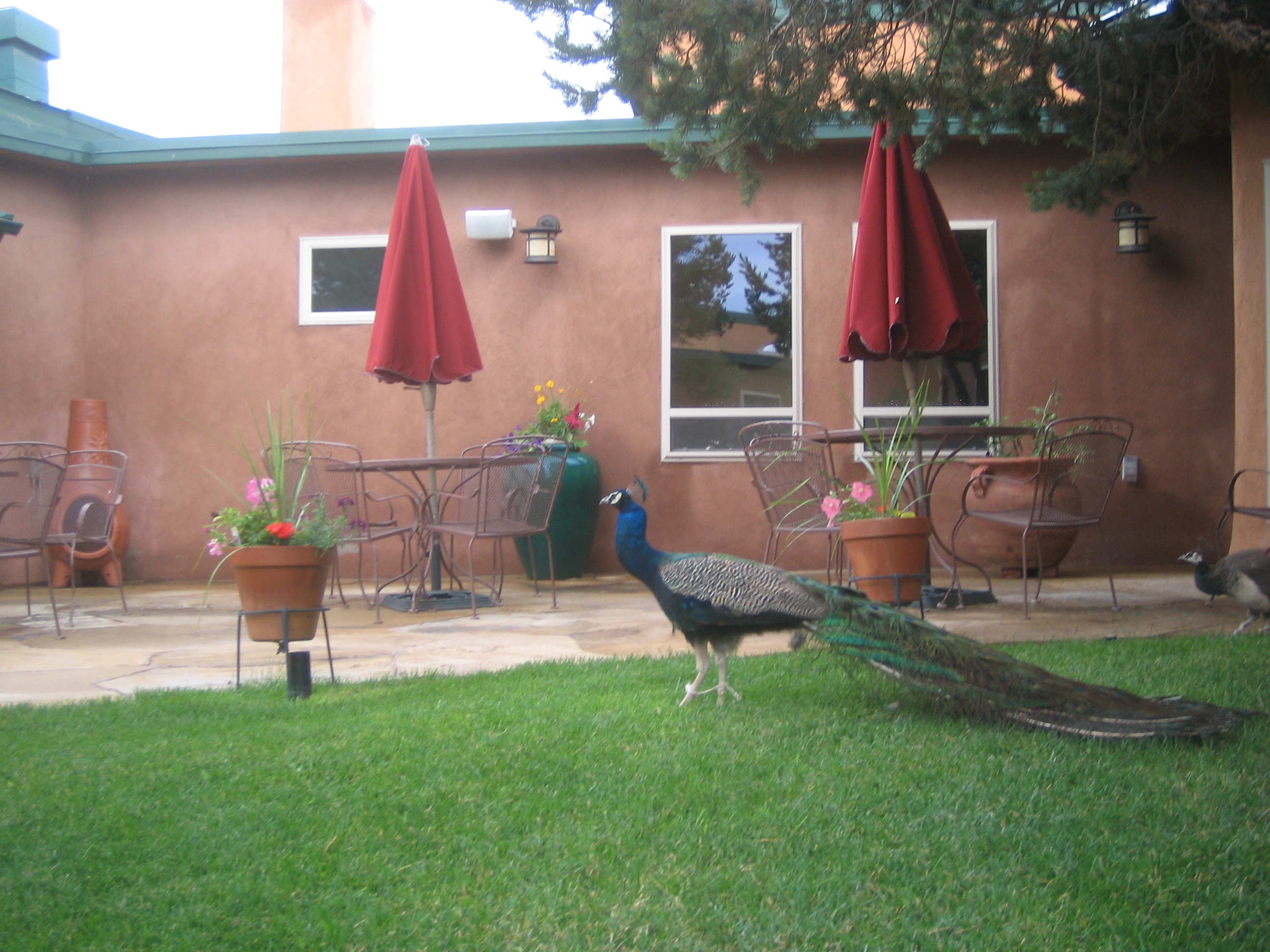 First, we hear a rooster crowing. Then Ron and I see a few goats and some chickens, nibbling happily in an outdoor enclosure. Their neighbors are a preening peacock and his mate, who’s proudly fanning her tail feathers. These animals are our initial introduction to Sierra Vista Retirement Community in Santa Fe, NM, a dementia care facility and an Eden Alternative Care Community.
First, we hear a rooster crowing. Then Ron and I see a few goats and some chickens, nibbling happily in an outdoor enclosure. Their neighbors are a preening peacock and his mate, who’s proudly fanning her tail feathers. These animals are our initial introduction to Sierra Vista Retirement Community in Santa Fe, NM, a dementia care facility and an Eden Alternative Care Community.
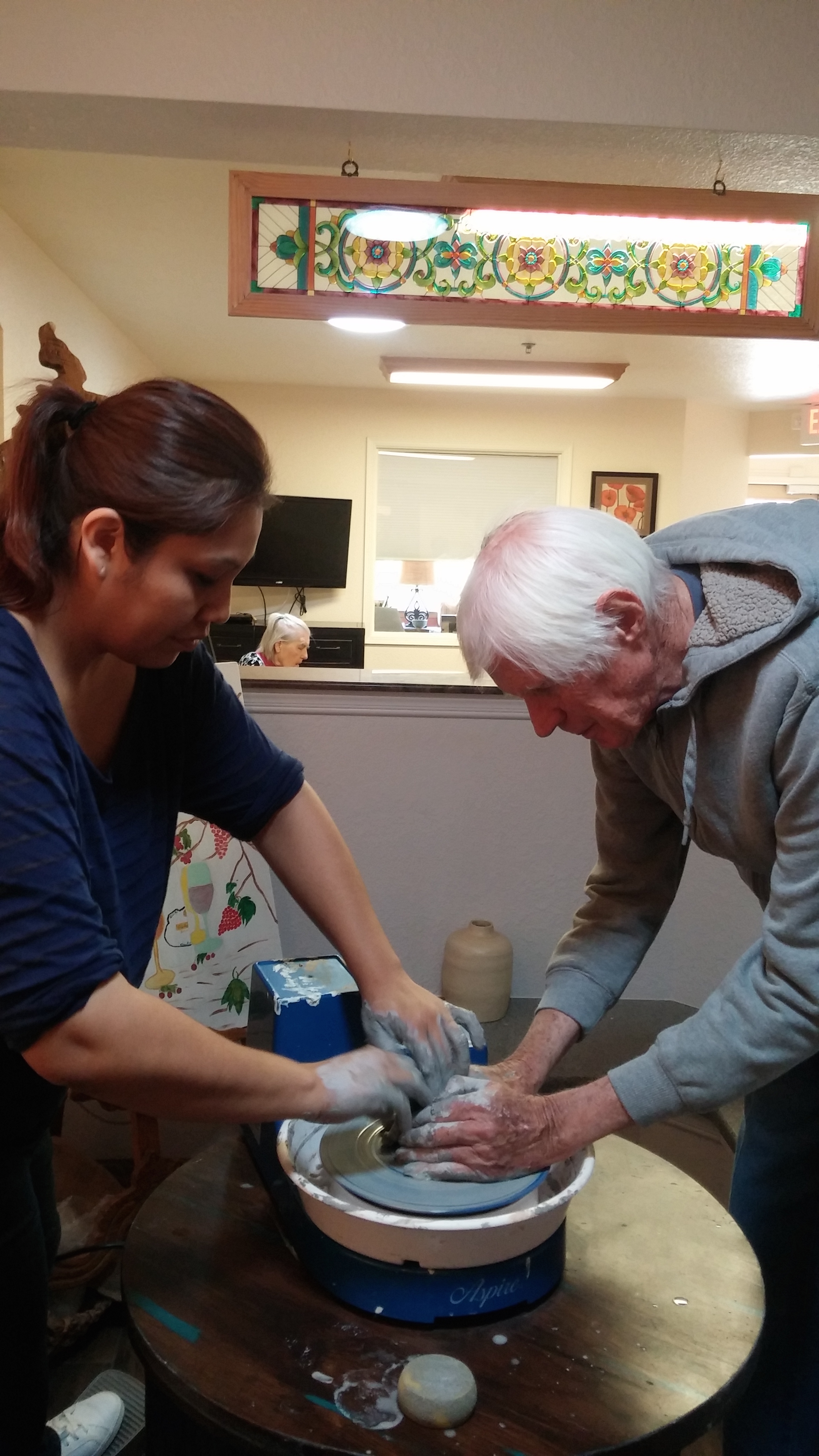 Dr. Bill Thomas founded the Eden concept, and we were intrigued by his philosophy: no matter how old we are, life is about continuing to grow. Care is collaborative, a balance of giving and receiving. Together, care partner teams strive to enhance well-being by eliminating the three plagues of loneliness, helplessness, and boredom. The Elder-centered community revolves around close and continuing contact with plants, animals, and children, believing these relationships provide young and old alike a life worth living.
Dr. Bill Thomas founded the Eden concept, and we were intrigued by his philosophy: no matter how old we are, life is about continuing to grow. Care is collaborative, a balance of giving and receiving. Together, care partner teams strive to enhance well-being by eliminating the three plagues of loneliness, helplessness, and boredom. The Elder-centered community revolves around close and continuing contact with plants, animals, and children, believing these relationships provide young and old alike a life worth living.
Ruth Dennis, Social Services Director of Sierra Vista, welcomes us and shows us into the home. We are greeted by wooden floors, an upright piano, the sweet tweet of birdsong, and a smiling elder. Colorful artwork, created by the elders, crowns every hallway, adding a vibrancy and energy.
I try to imagine what it would have been like to visit my mom in such a home-like facility and I am so emotionally moved by the idea of being together in this comforting home that I burst into tears. Fortunately, Ruth understands and envelops me in a big hug.
Opening the Door and Opening the Heart
 As we stroll through the spacious home, Ruth shows us the nursing office, which features a Dutch door, so elders can see what’s going on. The nurse, Shauna, welcomes their interest and occasional assistance.
As we stroll through the spacious home, Ruth shows us the nursing office, which features a Dutch door, so elders can see what’s going on. The nurse, Shauna, welcomes their interest and occasional assistance.
The laundry room also has half-doors.
“Elders are welcome to get involved with folding clothes. They help with the house as often as possible” Ruth says.
The spacious open kitchen, with a friendly chef/ Care partner chopping yellow and red peppers, lets residents see and smell the food. All staff takes turns with cooking, and elders often help.
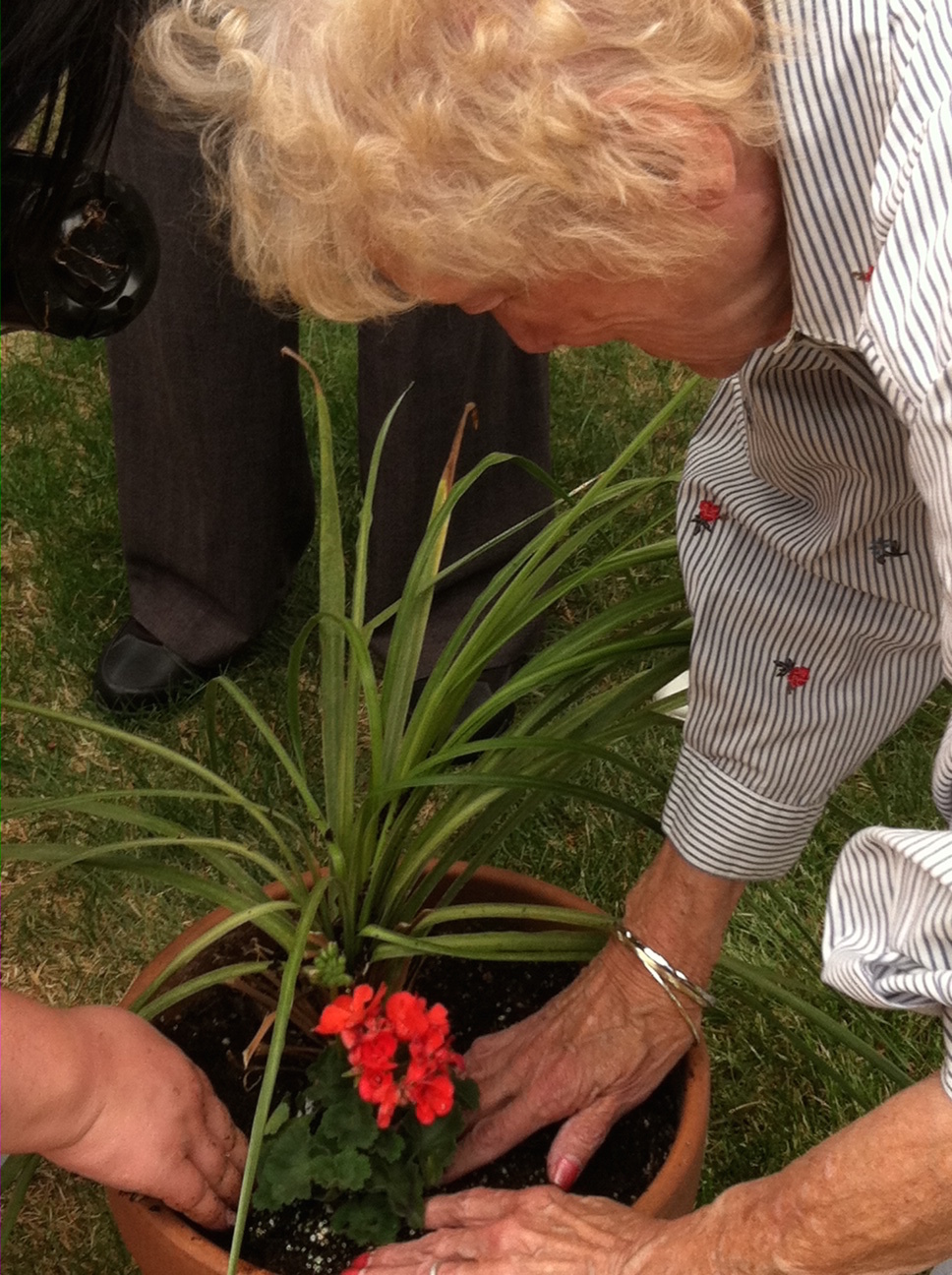 “Soon, it will be warm enough to start our vegetable and flower gardens,” Ruth says, leading us into a lovely courtyard. Residents can wander into the outdoor area whenever they wish. This becomes the summertime living room.
“Soon, it will be warm enough to start our vegetable and flower gardens,” Ruth says, leading us into a lovely courtyard. Residents can wander into the outdoor area whenever they wish. This becomes the summertime living room.
 Towards the front of the building, in the living room, picture windows allow a grand view of the goats and chickens as well as the beautiful New Mexico Mountains. Elders can watch the animals’ antics and the change of seasons from the comfort of easy chairs and sofas.
Towards the front of the building, in the living room, picture windows allow a grand view of the goats and chickens as well as the beautiful New Mexico Mountains. Elders can watch the animals’ antics and the change of seasons from the comfort of easy chairs and sofas.
Inviting Choices and Connections
Creativity and choice are key in this environment. Ruth describes a flow of interesting activities, telling us, “We offer options, so elders can gravitate towards the project that most interests them.”
Ron and I have spent a fair amount of time in memory care facilities and we have been very grateful for the care and community our beloved parents received there. But this Eden home has a different feel and look. Where are the shining linoleum floors, the stark white hallways, the cluster of slumbering elders in wheelchairs, the stark nursing station? Where is the cheerful game of Bingo and the large screen TV blaring The Price is Right? Elders here are given another set of alternatives that that is focused on the simple pleasures of life; beautiful art, loving pets, music and an opportunity to help others.
“We try to control the television; we don’t want TV to replace life” Ruth says, as we savor their big screen, which features the soothing movements of dolphins leaping through brilliant blue ocean water to the background of classical music.
“Our elders are encouraged to stay involved with life, to be connected with the pleasures and joys of living,” she says. “Life is embraced through having a constant connection to animal companions, art, music and loving relationships.”
For more about the Eden Alternative concepts and care facilities, please visit www.edenalt.org/about-the-eden-alternative/
Deborah Shouse is the author of Love in the Land of Dementia: Finding Hope in the Caregiver’s Journey.
Two Secrets to Creating a Thriving Dementia Care Community: Arts and Collaboration
“Art is the vehicle for creating connection and community,” Ari Albright said, as we toured her eclectic art studio/teaching space in Vermillion, South Dakota. Ari serves as Program Coordinator and Artist-in-Residence for Sanford Arts Vermillion (SAV), located at Sanford Vermillion Medical Center. We’d read about her innovative approach to arts and dementia and we wanted to learn more. During our visit, we witnessed much more than an arts program. From the executive team to the nursing team to the dietary staff, we experienced a powerful spirit of collaboration and a dedication to enriching the residents’ lives through the arts. This sense of purpose permeated Sanford Vermillion Medical Center, which contains a hospital, clinic, independent living center, and a long term care facility, complete with a special care dementia unit.
After our tour of her studio, Ari led us over to the facility’s boardroom, where we met Mary Merrigan from Public Relations, Cindy Benzel from Human Resources, and Jill Christopherson, Executive Assistant.
“Ari was brought in to enrich activities in the long term care center,” Mary told us. “Our staff completely embraced the program: it made their work less rote and more meaningful.”
Tim Tracy, CEO, dropped in to greet us. “We’re very proud of the program and of Ari,” he said. “It’s made a big difference in the lives of our residents and of our staff.”
Setting Goals and Exceeding Expectations
Since 2011, Ari has facilitated arts engagement in healthcare environments. She started doing art projects with the patients, staff, and families at the Sanford Cancer Center and Children’s Castle of Care Hospital in Sioux Falls, South Dakota. In 2012 when Ari approached Tim and his team about bringing her participatory program to Sanford Vermillion, they were interested. Tim, along with Ari and members of the executive and care teams, set three goals for the art program:
- Enrich activities for residents with dementia and special needs adults
- Uplift the environment by offering art displays on the center’s walls
- Care for caregivers by taking the redundancy out of the staff’s daily job
Ari’s program, which consisted of three to four weekly two-hour art programs that supplemented the on-going activities agenda, worked beyond their expectations. Ari trained members of the care team to become involved in art activities, both when she was there and when residents needed something soothing or meaningful to do. She worked with volunteers and family members. She created “Art Kits,” a rainbow-colored box with an easy project that a resident could do on her own.
The residents participated in every aspect of this multi-faceted textile art project, which now hangs in the special care unit. This was inspired by Wassily Kandinsky’s Color Studies.
In 2012, 30 percent of the facility’s 62 residents were taking psychotropic medications. (The national norm is between 25-30%). By the end of 2013, when the arts program had been in place for one year, only 20 percent of the 65 residents were taking the medications. Ten residents had a reduction in medications and seven simply no longer needed the drugs. In October of 2014, after two years of the arts program, only three percent were taking psychotropic medications. Reducing these strong medications enriched the residents’ quality of life in a variety of ways, including making them less susceptible to falls, increasing their alertness, and piquing their appetites. Ari’s media included painting, sand, clay, fabric, and origami. Along with the tactile and visual experiences, she wove in literary arts, music, and movement. These projects increased residents’ creative thinking, decision-making, playfulness, cooperation, conversations, patience, and sense of meaning. The families were often astonished by the creations and contributions of their loved ones. The staff felt a greater connection with the residents and an increased sense of empowerment.
“The artistic tools are only a catalyst for connection,” Ari says. “This program is about the process of doing something that feels relevant.”
 This literary arts project inspired important memories. This was facilitated by visiting SDAC Artist and writer, B.J. Buckley.
This literary arts project inspired important memories. This was facilitated by visiting SDAC Artist and writer, B.J. Buckley.
It Takes a Team To Say Yes! To Art and No to Psycho-tropic Drugs
A collaborative team of executives, management, and staff worked together to implement and integrate this arts program. Each one played an important role. The executive team paved the way, finding funding, navigating the system, and offering vital goal setting and guidance. Nursing professionals and social workers educated doctors, family, and staff on the program’s benefits and created time for staff to participate. The dietary department displayed residents’ artwork on the cafeteria walls and now hosts quarterly artists’ reception.
This is part of the team from Sanford Vermillion Medical Center that improved residents’ lives by embracing participatory arts programs in their senior living and special care communities. Back row: Kay Hoesing, MDS Coordinator; Gayle Matzke, DON; Jeff Berens, CNO; Rebecca Froehlich, SAV Intern/Volunteer; Ron Zoglin; Front row: Jill Christopherson, Executive Assistant; Melissa Langle-Lee, Social Work; Deborah Shouse; Ariadne (Ari) Albright, Program Coordinator and Artist in Residence
For more information about Ari, visit
www.arialbright.com
Facebook page: Art with Ari
For more information about the Sanford Vermillion arts program, visit:
Sanford Arts Vermillion 20 E. Plum Street, Vermillion, SD 57069
Email: Ariadne.Albright@Sanfordhealth.org
Phone: 605-638-8580
www.sanfordvermillion.org
Do you have a story about collaboration, arts and dementia? If so, I’d love to hear it!
Deborah Shouse is the author of Love in the Land of Dementia: Finding Hope in the Caregiver’s Journey.
Three Reasons to Give Life Meaning by Giving Back
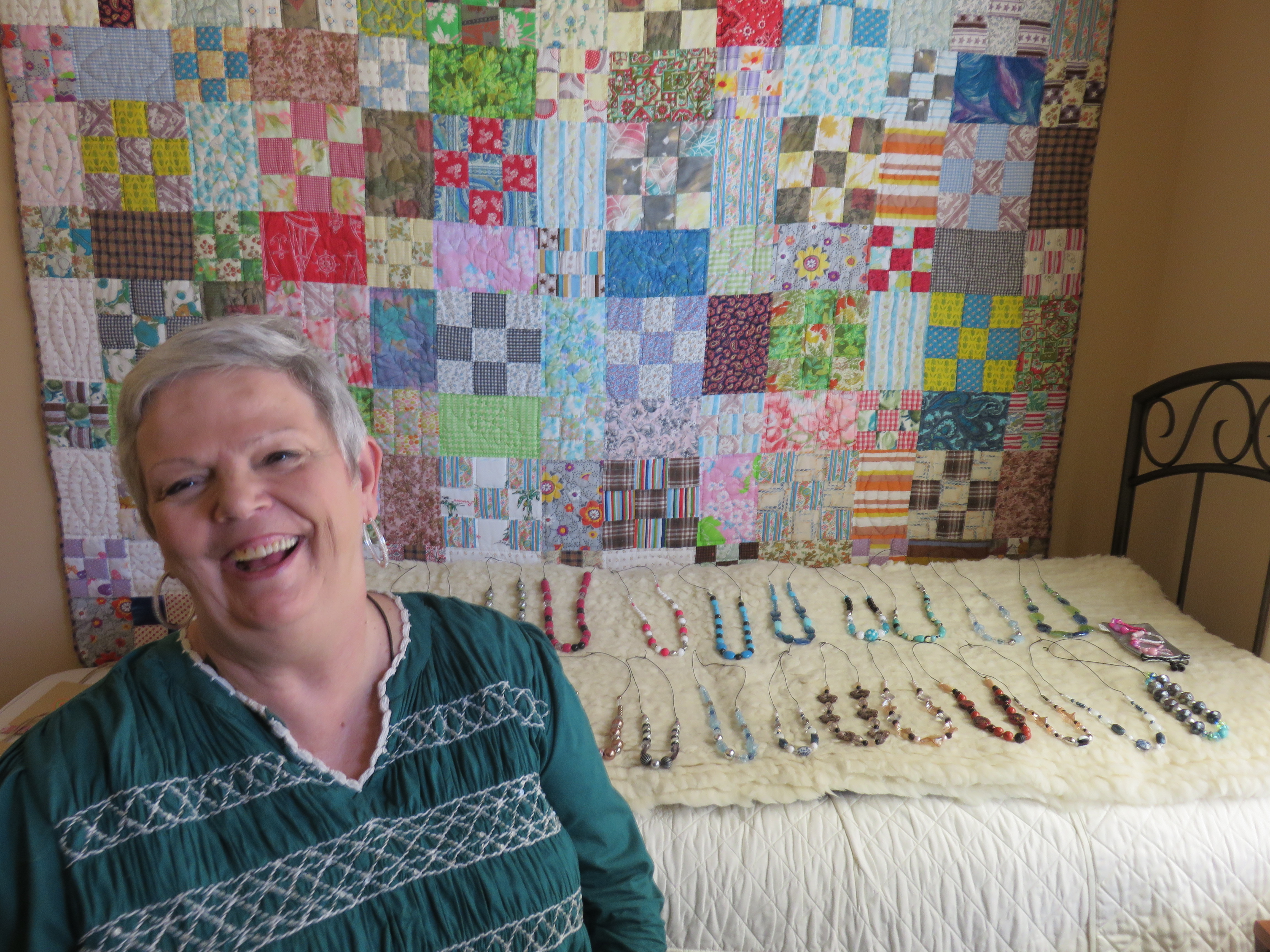 Even when she was traveling the globe, designing and creating family-oriented projects, such as children’s museums, farms and gardens, Vicki Stoecklin made time to volunteer. She’d work on projects in Thailand, Saudi Arabia, and China, but whenever she was home in Kansas City, Missouri, Vicki shared her time and talents with non-profit organizations including the Girl Scouts, the local food bank, a boy’s home and more.
Even when she was traveling the globe, designing and creating family-oriented projects, such as children’s museums, farms and gardens, Vicki Stoecklin made time to volunteer. She’d work on projects in Thailand, Saudi Arabia, and China, but whenever she was home in Kansas City, Missouri, Vicki shared her time and talents with non-profit organizations including the Girl Scouts, the local food bank, a boy’s home and more.
When Vicki was diagnosed with early-onset Alzheimer’s, her life radically changed; she had to give up her dynamic travel schedule and her demanding and rewarding career. But she never considered giving up her volunteer activities; in fact, she consciously began seeking more opportunities to give back to her community.
Many of her normal activities were no longer viable: she couldn’t drive, read or cook. Her normally stellar math skills were impaired. Suddenly, instead of having to make every minute count, she had nothing but time. Within these limitations, she had to reframe her life and find new activities that stimulated and engaged her.
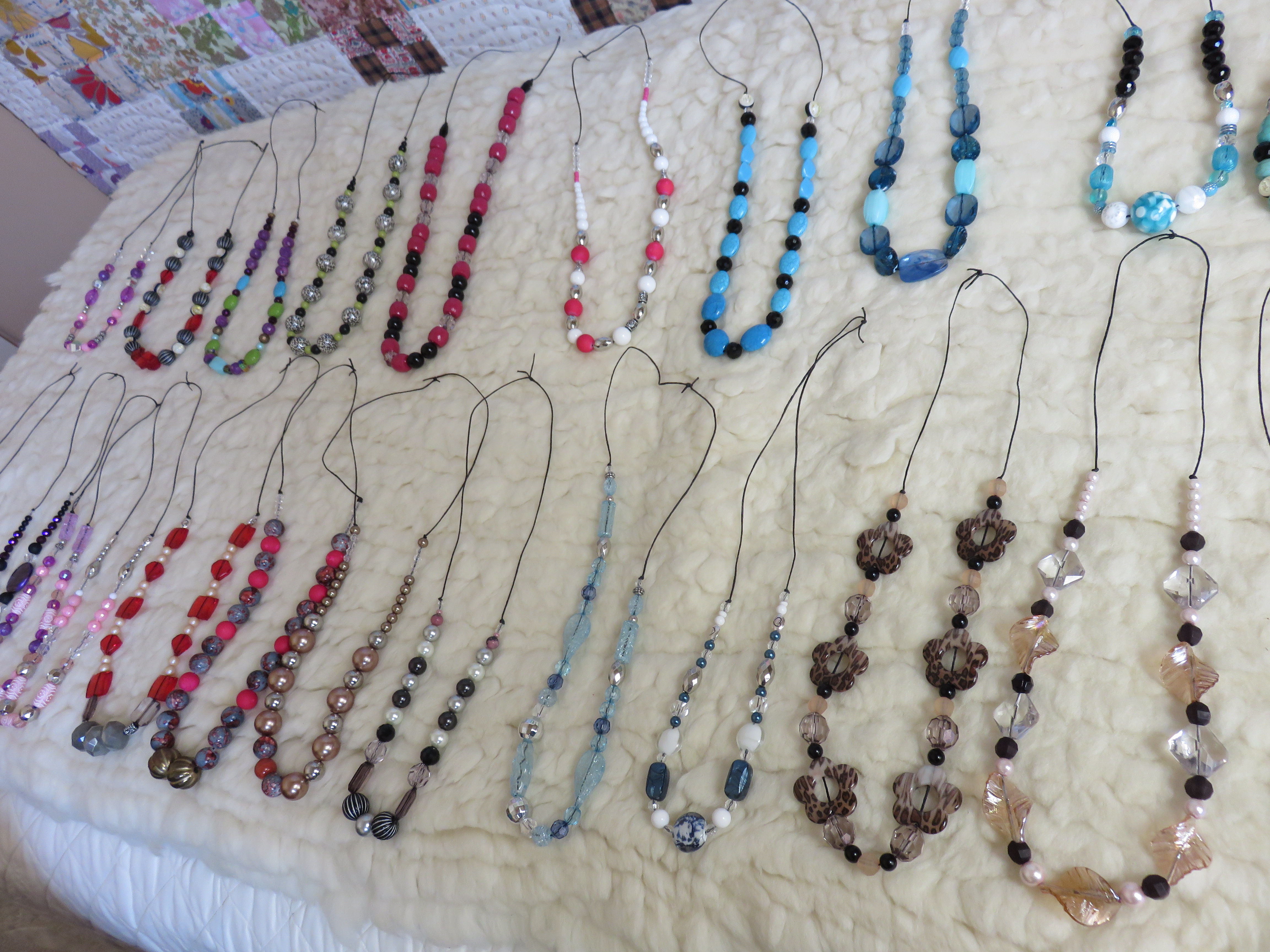 As Vicki pondered what to do with her life, she thought of Sheffield Place, a local shelter for single moms and their children. These women were struggling and rarely had enough money for any personal extras. Vicki decided to make necklaces for the mothers in the shelter. She enjoyed buying the beads and learning to string them in an artistically pleasing way, creatively combining colors, sizes and patterns. She also crafted a special gift bag for each necklace, decorating each with brightly colored stickers. When Vicki delivered her creations, the women and the staff were so grateful and so pleased. Their gratitude gave Vicki a sense of completion and connection.
As Vicki pondered what to do with her life, she thought of Sheffield Place, a local shelter for single moms and their children. These women were struggling and rarely had enough money for any personal extras. Vicki decided to make necklaces for the mothers in the shelter. She enjoyed buying the beads and learning to string them in an artistically pleasing way, creatively combining colors, sizes and patterns. She also crafted a special gift bag for each necklace, decorating each with brightly colored stickers. When Vicki delivered her creations, the women and the staff were so grateful and so pleased. Their gratitude gave Vicki a sense of completion and connection.
One day, riding home from an appointment, Vicki noticed a dog shelter.
The thought floated into her mind: Wouldn’t it be fun to make blankets for the dogs?”
So, she made small, cozy blankets for the animals in the shelter. She enjoyed picking out colorful flannel, sizing it, then cutting fringe around the edges, and tying two pieces of fringe into knots.
“Making these blankets was relaxing and therapeutic,” Vicki says. “The cutting and tying helped me maintain my fine motor skills and the easy nature of the project allowed other people to get involved.”
When friends saw the fabric lying across Vicki’s lap, they asked, “What are you making?” Vicki explained and soon her friends were sitting beside her, tying away.
“With my dementia, I have a hard time finishing a project, “Vicki says. “These art projects allow me to complete a craft and give me a sense of accomplishment. Plus, learning new skills stimulates my brain.”
For Vicki, being a productive person and making a contribution to society, rather than just sitting around, has given her a much-needed sense of creativity and purpose. She encourages others with a similar diagnosis to seek what brings them joy and open up to new ideas and activities.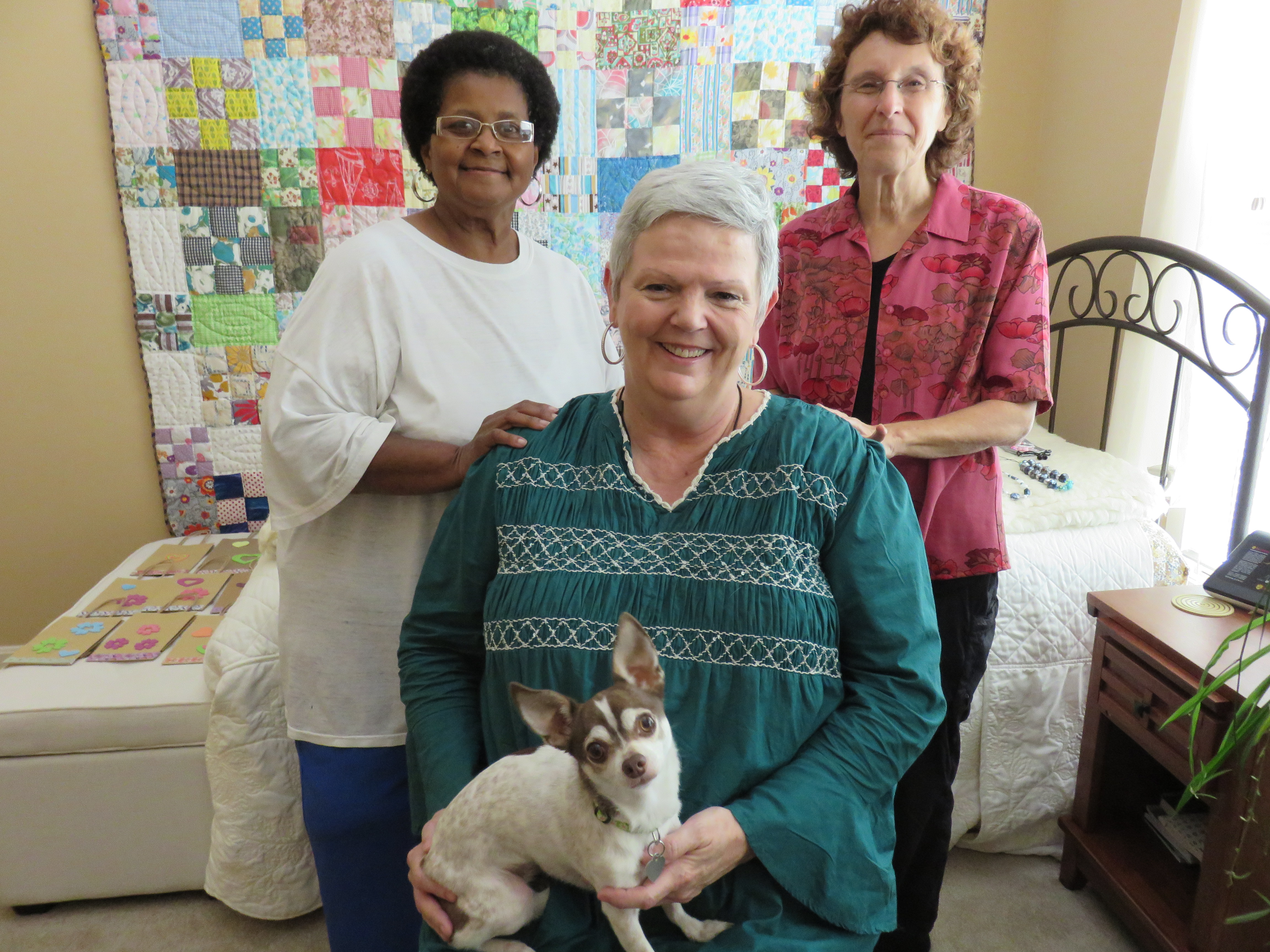
***
Finding ways to give back offers people a sense of purpose and a connection with others. Seek projects that are:
Tangible, finite and easy to finish
Fun to do alone or with others
Aligned with an organization the care partner can relate to
Connected to non-profits that can communicate gratitude
Deborah Shouse is the author of Love in the Land of Dementia: Finding Hope in the Caregiver’s Journey.
